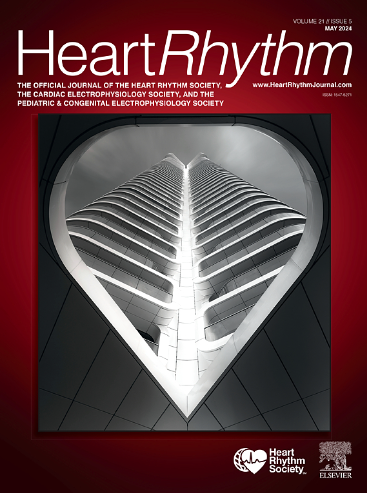Idiopathic ventricular arrhythmia originating from the vicinity of lateral tricuspid annulus: The precise origin and anatomic concerns
IF 5.6
2区 医学
Q1 CARDIAC & CARDIOVASCULAR SYSTEMS
引用次数: 0
Abstract
Background
Although the electrocardiographic and electrophysiological properties of ventricular arrhythmias (VAs) from the vicinity of the lateral tricuspid annulus (TA) have been reported in previous studies, their precise site of origin have not been addressed.
Objective
The purpose of this study was to describe the precise origin of lateral TA-VA and the relevant anatomy.
Methods
Consecutive patients with idiopathic lateral TA-VAs were reviewed and analyzed. Three-dimensional mapping system combined with intracardiac echocardiography (ICE) was used for anatomic reconstruction, mapping, and ablation.
Results
During the study period, 63 patients with lateral TA-VAs were included. Under ICE view, a prominent enfoldment structure was observed under the valve along the lateral TA. The muscular bundle was documented in all patients (100%) within the subvalvular enfoldment with an average number and diameter of 4 ± 2 and 4.10 ± 0.73 mm, respectively. Initial ablation was attempted via the anterograde approach in 15 patients but succeeded in none. To reach the ventricular side of the TA, the catheter needed to enter the ventricular chamber and retroflexed toward the atrial side with a reverse curve. The earliest activation site was found at the valvular end of muscular bundles in 51 of the 63 patients (80.9%) with a local activation time of –26.78 ± 4.63 ms. The VAs were eliminated after an average of 4 ± 2 seconds of ablation.
Conclusion
The ventricular side adjacent to the lateral TA exhibits a subvalvular enfoldment-like structure, which is rich in muscular bundles and serves as the origin of TA-VAs in most patients. To reach the origins, a reverse technique is required.

起源于三尖瓣环外侧附近的特发性室性心律失常:精确起源和解剖学问题。
背景:尽管之前的研究已经报道了来自三尖瓣环(TA)外侧附近的室性心律失常(VA)的心电图和电生理特性,但尚未涉及其确切的起源部位:目的:描述外侧三尖瓣环心律失常的确切起源和相关解剖结构:方法:回顾并分析特发性外侧 TA-VA 的连续患者。方法:对特发性外侧TA-VA患者进行回顾性分析,采用三维测绘系统结合心内超声心动图(ICE)进行解剖重建、测绘和消融:结果:在研究期间,共纳入了 63 名患有侧位 TA-VAs 的患者。在ICE视野下,沿外侧TA瓣膜下方观察到一个突出的包绕结构。所有患者(100%)均在瓣膜下包膜内发现肌束,其平均数量和直径分别为(4±2)毫米和(4.10±0.73)毫米。15 例患者尝试通过前向途径进行初始消融,但无一成功。为了到达 TA 的心室侧,导管需要进入心室腔,并以反向曲线向心房侧后屈。63 位患者中有 51 位(80.9%)的最早激活部位位于肌束的瓣膜末端,局部激活时间为 -26.78±4.63ms。平均消融 4±2 秒后,VA 被消除:结论:与侧 TA 相邻的心室呈现瓣下充盈样结构,其中有丰富的肌束,是大多数患者 TA-VA 的起源。要到达起源部位,需要采用逆向技术。
本文章由计算机程序翻译,如有差异,请以英文原文为准。
求助全文
约1分钟内获得全文
求助全文
来源期刊

Heart rhythm
医学-心血管系统
CiteScore
10.50
自引率
5.50%
发文量
1465
审稿时长
24 days
期刊介绍:
HeartRhythm, the official Journal of the Heart Rhythm Society and the Cardiac Electrophysiology Society, is a unique journal for fundamental discovery and clinical applicability.
HeartRhythm integrates the entire cardiac electrophysiology (EP) community from basic and clinical academic researchers, private practitioners, engineers, allied professionals, industry, and trainees, all of whom are vital and interdependent members of our EP community.
The Heart Rhythm Society is the international leader in science, education, and advocacy for cardiac arrhythmia professionals and patients, and the primary information resource on heart rhythm disorders. Its mission is to improve the care of patients by promoting research, education, and optimal health care policies and standards.
 求助内容:
求助内容: 应助结果提醒方式:
应助结果提醒方式:


